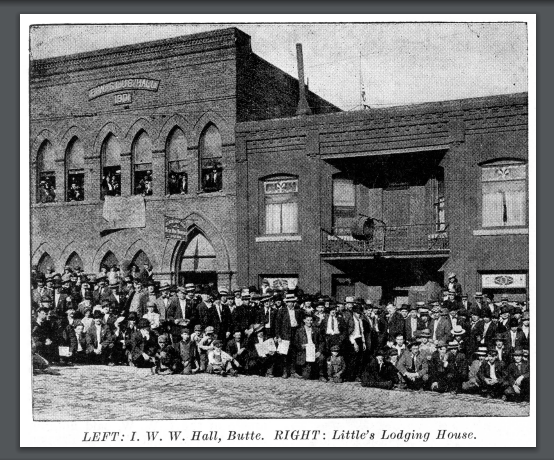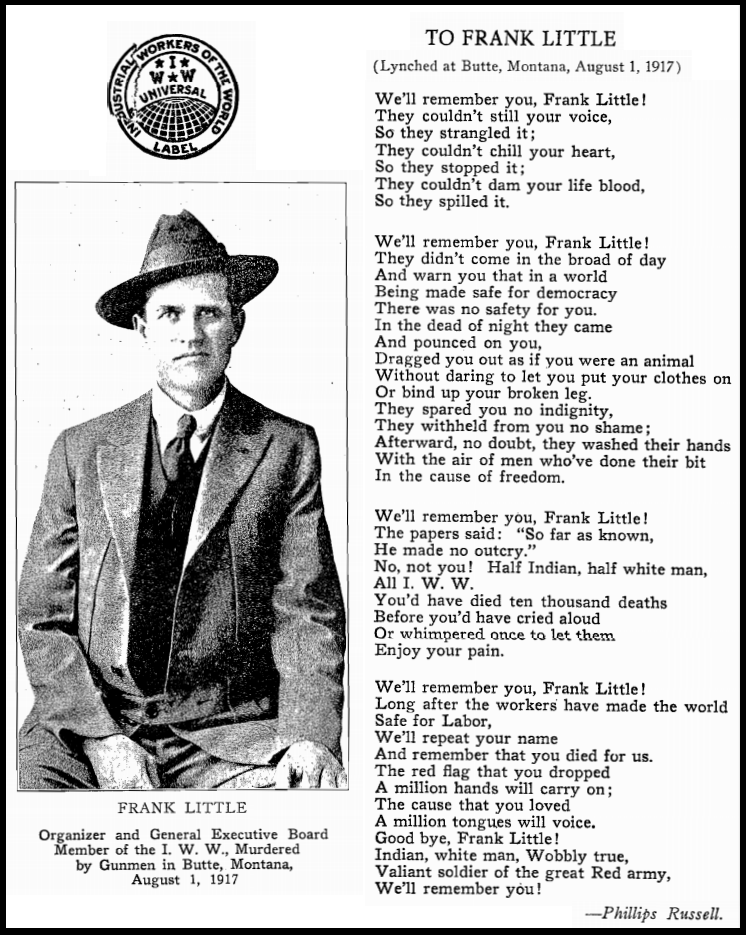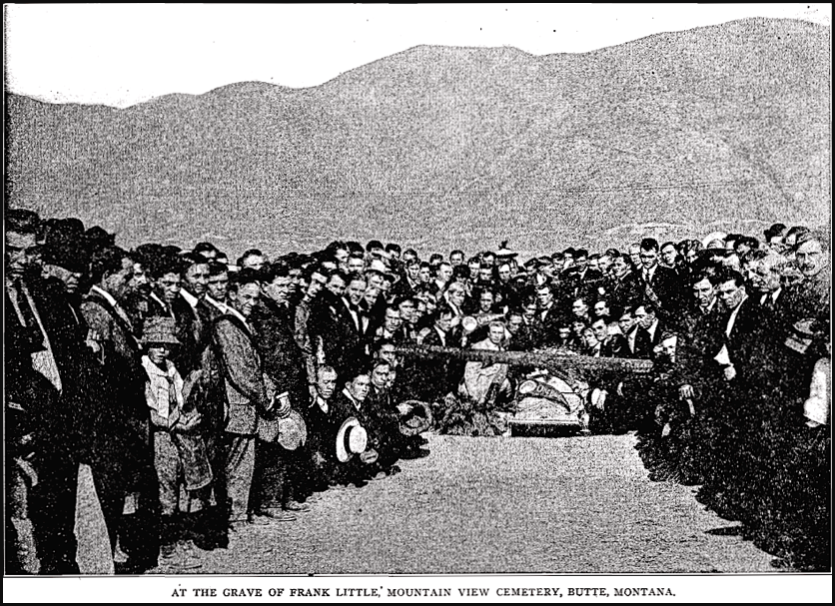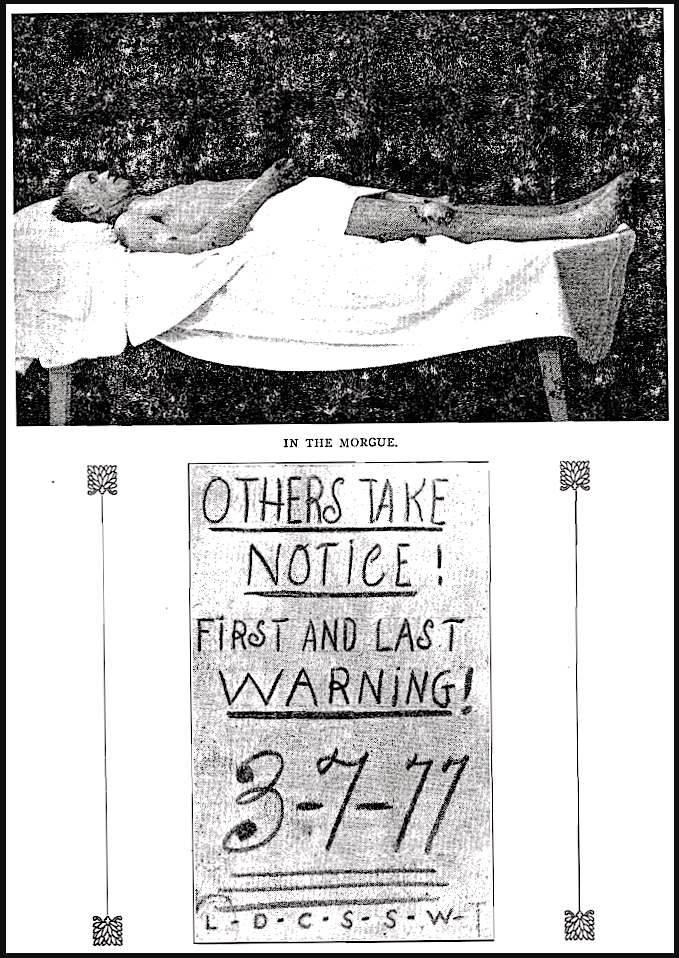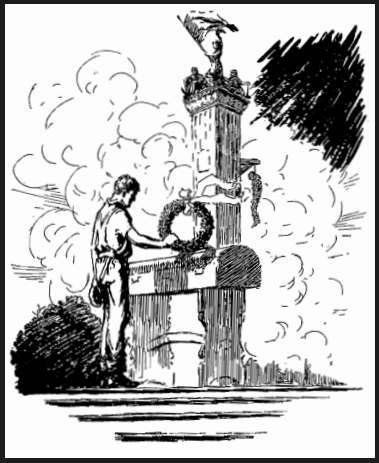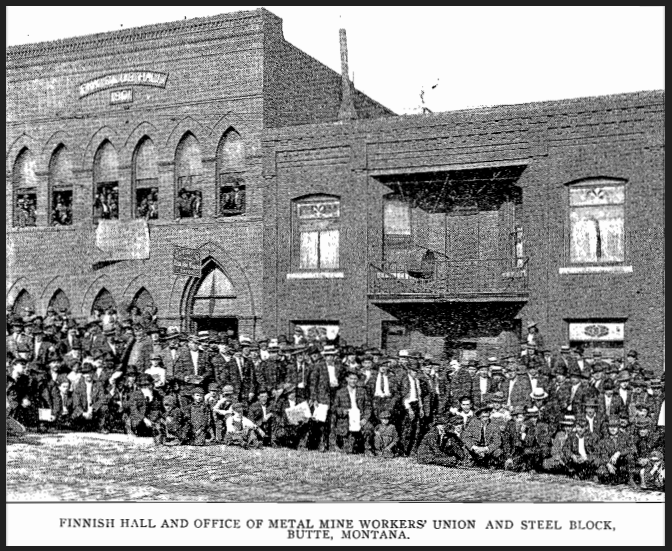We’ll remember you, Frank Little!
…We’ll repeat your name
And remember that you died for us.
The red flag that you dropped
A million hands will carry on.
-Phillips Russell
Hellraisers Journal, Monday September 3, 1917
Butte, Montana – Organizer Frank Little Remembered
From the International Socialist Review of September 1917:
“To Frank Little” by Phillips Russell
—–
Fellow Workers at Burial of Frank Little
—–
“They Got Frank Little”
The Man That Was Hung
WELL, they got Frank Little. No wireless message ever sped faster than these five words thru the world of labor. For on the first morning of this month an agitator was hung in Butte, Montana.
A social war has been going on in that hell hole of labor since the 12th of June. On the one side are the few mine owning capitalists represented by their henchmen and an army of 600 Standard Oil gunmen. On the other side are 17,000 unarmed striking copper miners with their Metal Mine Workers’ Union .
Came Frank Little, a fellow unionist, with a message of good cheer and solidarity from the miners of the southwest. He told them that their real enemy was the industrial kings and copper barons of America.
He repeated his words to Ex-Governor Hunt of Arizona:
Governor, I don’t care what you are fighting for, but we, the Industrial Workers of the World, are fighting for Industrial Democracy.
And the miners of Butte cheered his words.
The copper barons replied by sending six of their gunmen to “get” the damn agitator, who championed the cause of hated labor; who made war upon capitalism and the wage system, who advocated industrial democracy. The story of the assassination and what followed is told in the Montana Socialist.
Driven to desperation by the peaceful, non-resisting strike of the Metal Mine Workers, the company has played its last trump—murder.
I the gray of the morning of August 1, Frank Little, an I. W. W. organizer, was taken from his room in the Steel block by six masked men, hurried into an automobile, with no covering but his underclothes, driven swiftly to the Milwaukee railroad trestle near the Centennial brewery and hanged to the trestle. It was one of the most brutal, cruel, cowardly murders that ever disgraced an American city. Six armed men take this cripple, without a chance to defend himself, and after beating his head to a pulp, tied a rope around his neck and threw him off a railroad trestle. It was an act too fiendish and cowardly to credit even to a band of Sioux Indians. It is doubtful if Little ever knew that he was hung, for the blows on the head no doubt rendered him unconscious or made the hanging unnecessary except to gratify the murder-lust of the perpetrators.
Following the murder all three of the Butte daily papers came out with venomous editorials against the victim that might well encourage a repetition of this outrage and lay the blame on the federal authorities. It ill becomes the daily press of this city to excuse the murders by throwing the blame on the federal authorities because they did not take action against Little on account of remarks he made about this country and its government. This government does not need the help of midnight assassins to carry out the enforcement of the law. The federal authorities are no doubt as competent as the daily papers and the interests they represent to interpret what constitutes a violation of the law. Those who commit and condone midnight assassination are not safe guardians of the law.
And the daily press itself had made veiled threats of violence before Frank Little came to Butte. In the editorial quoted above the Standard hints that somebody has a card up their sleeve that they are going to play when the proper time comes. In the leading editorial on the Home Guards, in the same issue (July 1), it says:
“There may be nothing for the Home Guards to do, and again there may be. The city and county authorities are faithful and reliable and they are determined to maintain order, but they may need help at any time, and when they need it they should have it. The Guards should soon be able to render very effective assistance.”
In this issue of July 16, the Standard says editorially, “the agitators should take a lesson from what has happened in other sections of the country.”
First, we see trouble prepared for—then we see trouble predicted—then we see trouble started. There may be no connection, but it looks suspicious to any one familiar with the methods of the Standard Oil Company.
* * *
To those outside of Butte, who are not acquainted with conditions here, let it be said that while Butte is within the confines of the United States, it is a principality of the Standard Oil Company. While the working people are peaceful and law abiding, the rulers care no more for a law that stands in the way of the accomplishment of their ends than a cow does for a cobweb. Anyone who knows the history of the Standard Oil Company knows that it will trample under foot any law that stands in the way of the creation of profits.
The fact that all thru this strike, since the 12th of June, there has been no violation of the law except on the part of officials and gunmen, proves that the working people of this community are exceptionally slow to resort to violence. Under the most aggravating and exasperating circumstances they have kept their heads and refrained from any overstepping of their legal rights which might be taken as an excuse for the company to inaugurate a campaign of murder and terrorism, such as occurred at Ludlow.
The papers for several days have been telling us that more and more men were going to work and that soon the mines would be running about normal. If this were true then what was the need of resorting to murder to try to break the ranks of the striking miners? If the company has plenty of men to run the mines, why should it care how long the Metal Mine Workers remain on strike?
The truth of the matter is that all this talk about the increased output of the mines was a big bluff. The mines are not turning out the dividends that have been promised the stockholders. The heart of the Standard Oil Company is profits and to cut out the profits is the same thing as cutting out its heart.
* * *
And again they have failed. Again the workingmen refused to fall for their game, but are still sitting with folded arms. With all their army of spotters and eaves-droppers they have only been able to report one threat made in the heat of passion, which is said to have been made by one man in front of Finlander hall. And who knows but that this is a reporter’s lie.
The thing that stands out most prominent in this strike is the peaceful manner in which it has been conducted. We do not know of a strike of such magnitude ever having been carried on for such a length of time with so little disturbance. Only a couple of days ago a policeman, on what is considered one of the toughest beats in Butte, said that the town was the quietest he ever saw it. “Why,” said he, “a year ago I used to make over a dozen arrests a week, and now I have not seen a fight in six weeks. Finest time I ever saw for a policeman.”
But in all this turmoil the student of economics and history sees the age-long class struggle. The crime of Frank Little was that he was on the side of the working class. And in his death he has aided the class he represents more than he could do by talking a hundred years.
The papers endeavored to magnify every utterance of this man to the proportions of treason; yet, most of the things he said are, and for many months have been, heard wherever men congregate and discuss current events.
Be that as it may, the grewsome fact remains that Frank Little was foully murdered—and his murderers are still at large.
But, the working people of this district are aroused—and every one in Butte now realizes it.
Nearly seven thousand people—to be exact, 6,800—followed Frank Little’s body to,its last resting place.
Electrical Workers, Street Carmen, Blacksmiths, Machinists, Boilermakers, and a number of other unions marched as a body, the Pearce-Connolly Club, wearing their colors, marched near the head of the procession, which was led by hundreds of women and children, mothers with babes in their arms or push carts. Thousands of miners were in line.
What induced these thousands of working people to march?
Simply their determination to call a halt on such murderous tyranny.
If you want to help the Butte miners win send a contribution to Tom Shannon, Butte, Montana, 318 N. Wyoming street.
—–
Butte, Montana-Scene of Kidnapping
Finnish Socialist Hall on left, and Frank Little’s boarding house on right.
SOURCE & IMAGES
International Socialist Review Volume 18
(Chicago, Illinois)
Charles H. Kerr and Company
July 1917-June 1918
https://archive.org/details/ISR-volume18
ISR Sept 1917
https://archive.org/stream/ISR-volume18#page/n66/mode/1up
To Frank Little by Phillips Russell, ISR Sept 1917
https://archive.org/stream/ISR-volume18#page/n68/mode/1up
Frank Little, FWs at Grave, ISR Sept 1917
& “The Man That Was Hung”
https://archive.org/stream/ISR-volume18#page/n69/mode/1up
Frank Little, Morgue and Warning, ISR Sept 1917
https://archive.org/stream/ISR-volume18#page/n70/mode/1up
Frank Little, Wreath for Labor Martyr, ISR Sept 1917
https://archive.org/stream/ISR-volume18#page/n71/mode/1up
Frank Little, Finnish Hall, Boarding House, ISR Sept
https://archive.org/stream/ISR-volume18#page/n95/mode/1up
See also:
Category: Frank Little
https://weneverforget.org/category/frank-little/
Note: The Standard mentioned above in article is most likely The Anaconda Standard, mouthpiece of Anaconda Copper Mining Company (ACM).
(Also per Botkin.)
http://chroniclingamerica.loc.gov/lccn/sn84036012/
Frank Little and the IWW:
The Blood That Stained an American Family
-by Jane Little Botkin
University of Oklahoma Press, May 25, 2017
Note: This is the definitive biography of Fellow Worker Frank Little. Jane Little Botkin is the great grand niece of Frank and Fred Little. Book is thoroughly and diligently sourced.
https://books.google.com/books?id=gBskDwAAQBAJ
Note: The I. W. W. Hall (Metal Mine Workers Industrial Union No. 800) was located in the Finlander Hall along with other unions, most notably the Butte Metal Miner Workers Union-Independent.
(Scroll way down.)
https://www.marxists.org/history/usa/pubs/labordefender/1926/v01n08-aug-1926-LD.pdf
